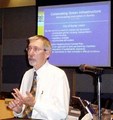Companion Website: Green Infrastructure community-of-interest promotes 'designing with nature'

Under the umbrella of the Water Sustainability Action Plan for British Columbia, the Green Infrastructure Partnership and the Water Bucket Website Partnership collaborated to develop the Green Infrastructure Community-of-Interest in 2005. The vision for the website is to build capacity through the sharing of experiences, approaches and lessons learned by practitioners in implementing green infrastructure policies and practices that advance the state-of-the-practice in designing with nature.
The Green Infrastructure Community-of-Interest is a companion website to both the Water Balance Model Community-of-Interest and to the Rainwater Management Community-of-Interest. Both of these sites are maintained by the Inter-Governmental Partnership which is responsible for the Water Balance Model powered by QUALHYMO.
Distinguishing Natural from Engineered Green Infrastructure
Two complementary strategies can “green” a community and its infrastructure: first, preserving as much as possible of the natural green infrastructure; and secondly, promoting designs that soften the footprint of development.
Green infrastructure design is engineering design that takes a “design with nature” approach, to mitigate the potential impacts of existing and future development and growth; and to provide valuable community services.
Design with Nature Explained
“In promoting infrastructure practices that achieve design with nature outcomes,  the Green Infrastructure Partnership has borrowed from the title of the 1969 book by Ian McHarg”, explains Paul Ham (City of Surrey), Past-Chair of the Green Infrastructure Partnership, “We are consistent with what McHarg intended in terms of ecological planning and letting the landscape inform development. Four decades later, McHarg”s book continues to be one of the most widely celebrated books on landscape architecture and land-use planning.”
the Green Infrastructure Partnership has borrowed from the title of the 1969 book by Ian McHarg”, explains Paul Ham (City of Surrey), Past-Chair of the Green Infrastructure Partnership, “We are consistent with what McHarg intended in terms of ecological planning and letting the landscape inform development. Four decades later, McHarg”s book continues to be one of the most widely celebrated books on landscape architecture and land-use planning.”
“In practical terms, what designing with nature means…is essentially a restatement of Smart Growth principles”, adds Raymond Fung (District of West  Vancouver), current Chair of the Green Infrastructure Partnership Steering Committee. In a 2007 Showcasing Green Infrastructure Innovation Series presentation, Fung reported that “What we have found is that the term Smart Growth is sometimes highly charged and political. People often get their backs up because they associate “smart growth” as being all about imposing higher density development. We find that people intuitively understand what designing with nature means. It is non-threatening.”
Vancouver), current Chair of the Green Infrastructure Partnership Steering Committee. In a 2007 Showcasing Green Infrastructure Innovation Series presentation, Fung reported that “What we have found is that the term Smart Growth is sometimes highly charged and political. People often get their backs up because they associate “smart growth” as being all about imposing higher density development. We find that people intuitively understand what designing with nature means. It is non-threatening.”
Posted August 2008

